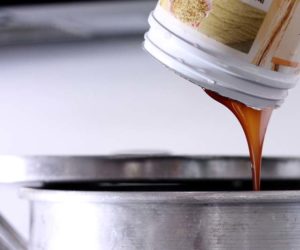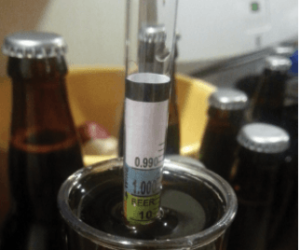Color Tips for Extract Beers: Tips from the Pros
Brewer: Chris McKim, The Brew Kettle Taproom and Smokehouse in Strongsville, OH
When I first started brewing there were not that many extracts available and the quality was sometimes questionable. There is a lot more to choose from these days, with many extracts capable of producing high quality brews. It is important for extract brewers to know, however, that they are essentially brewing another brewer’s recipe. In other words, let’s say some brewer in Australia, as an example, picked the base malt and some specialty malts to make up the wort, which eventually became the extract. An extract brewer’s job is to simply re-hydrate the original wort, ferment it, and call it his or her own.
Some homebrewers do not want someone else determining the final composition of their beer. I think it is possible to get around this conundrum by using the lightest malt extract you can find. In this way, you will be able to determine what specialty malts comprise the color and flavor of your favorite brew.
In our brew-on-premise site we use as little amber or dark malt as possible for all of our beers. As an example we might use 5 drums of light malt per week compared to barely one drum of dark malt. An imperial stout recipe that we produce contains four pounds of dark malt but 15 pounds of light malt! We then round out the flavor and create our own version of imperial stout by adding honey, black malt, roasted barley and chocolate malt. This is no different than an all-grain brewer using a pale malt as the back bone of his stout.
In our recipe, little color and flavor impact is derived from the dark malt — there is some, but not much. By adding specialty grains, determined by our own requirements for our beer, we ultimately create our own flavors, colors and aroma.
Almost everything in our brew-on-premise site is a “mini-mash,” or partial mash. Roughly 50 percent of the fermentable sugars come from the mashed grain and the extract. One reason that we use the mini-mash is to achieve the desired flavor and color profiles of certain styles. The extract itself has already suffered a degree of flavor deterioration through processing, packaging, storage, transportation and age, so we use grain to bring some flavor freshness back into the beer.
Though utilizing the mini-mash is a great way to achieve your color targets, the alternative is to go all-extract. In this instance, grains with no enzymatic activity are going to provide your beer with color. Picking those grains is really a question of where you want to go with your beer. Do you want to make brown ale or stout? If so, chocolate malt is a good idea. Do you want to pick up colors of varying degrees in the ale category? Try caramel malt.
Our American Pale Ale, for example, uses Caramel 10 with a touch of biscuit malt for mouth feel. Choosing grains for color is a journey. Experience will teach you the appropriate amounts. Remember that color and flavor will generally move in tandem with each other. More black malt, for example, will make your beer darker with a more acrid flavor. It is usually smart to start conservatively and make small changes to successive brews. This way you can discover the true impact that your favorite grains have on color and flavor.
Besides grains, your heat source is another driving force behind the color of your extract beer. The temperature difference between the flame and the wort sugars can vary dramatically — by hundreds of degrees — and super-heating those sugars with an extremely high flame will cause the sugars to caramelize. The differential between the heat source and the sugars is the key here, so you need to minimize that differential. Steam works best, but that is not feasible for most homebrewers.
With direct gas or electric heat, it is best to bring that heat up slowly. If you keep the flames to a minimum and slowly increase them as the wort comes up to temperature, your light extract will produce a light-colored beer (excluding the addition of any dark grains). You might get something with the color of, say, a Molson Golden. But really crank out the heat all at once and the sugars will scorch, resulting in your light extract producing an IPA-colored brew.
Brewer: Bret Kuhnhenn, Kuhnhenn Brewing Company in Warren, MI
We always start out with a light liquid malt extract. We want an extract that will closest resemble a 2-row barley — something appropriate for producing a Pilsener or similarly light colored brew. A homebrewer making an average size batch of five gallons with three pounds of specialty grains would want to start with two gallons of water. To this, the brewer should add only about one-quarter of the total liquid malt extract. This will acidify the water to between 5.0–6.0 pH. This is a good range for soaking the specialty grains.
Water that is not acidified enough tends to pull tannins out of the husks of your specialty grains. This problem is made worse when you use darker malts. The resulting off-flavor is a common one for extract brewers, but one that is easily avoided if you monitor the acidity of your diluted wort.
Soak the specialty grains for 30–45 minutes. That is an adequate time to extract the qualities you need to achieve your flavor and color goals. I recommend rinsing the grains lightly when you remove them. This flushes any residual sugars that may be caught in the grains. Be sure to use acidified water — again between 5.0–6.0 pH. You only need a couple of quarts.
Bring this solution to a boil for one hour and add the remaining extract during the last twenty minutes of the boil. Remember that the extract was already boiled before it was evaporated, so there is no reason to boil it again. Adding the remaining extract in the last twenty minutes hydrates and sterilizes it. If you boil all the extract for one hour, then the beer ends up being darker than wanted.
This is because evaporators are hot. After evaporation, what might have produced a 1.8 ºL beer would now result in a 5 ºL brew. Boiling also adds oxygen and causes a Maillard reaction, which is basically a transformation of sugar to non-sugar (or caramelization). This makes the wort even darker.
Homebrewers should also conduct a whirlpool and a 30-minute rest. The hops, proteins and flour will separate during the whirlpool, which allows you to achieve a clearer beer. Extract brewers can substitute light liquid malt extract for all the malt that they would use in an all-grain beer and use specialty malts for color and flavor.



